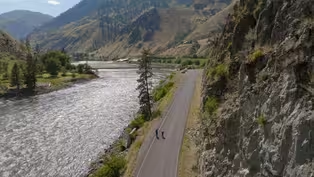Oregon Field Guide
Astrophotography
Clip: Season 36 Episode 9 | 8m 13sVideo has Closed Captions
Oregon astrophotographers capture cosmic wonders using surprisingly accessible tech.
Oregon stargazers are proving you don't need dark skies or remote locations to capture stunning celestial images. Using everything from smartphone apps to sophisticated telescopes with narrow-band filters, they're photographing galaxies and nebulae without having to leave their street.
Problems playing video? | Closed Captioning Feedback
Problems playing video? | Closed Captioning Feedback
Oregon Field Guide is a local public television program presented by OPB
Oregon Field Guide
Astrophotography
Clip: Season 36 Episode 9 | 8m 13sVideo has Closed Captions
Oregon stargazers are proving you don't need dark skies or remote locations to capture stunning celestial images. Using everything from smartphone apps to sophisticated telescopes with narrow-band filters, they're photographing galaxies and nebulae without having to leave their street.
Problems playing video? | Closed Captioning Feedback
How to Watch Oregon Field Guide
Oregon Field Guide is available to stream on pbs.org and the free PBS App, available on iPhone, Apple TV, Android TV, Android smartphones, Amazon Fire TV, Amazon Fire Tablet, Roku, Samsung Smart TV, and Vizio.
Providing Support for PBS.org
Learn Moreabout PBS online sponsorship(insects chirp) - I have this app and I can use it to see the sky.
So like if I move it here, there's a bright star right there, and I can know that's Cygnus, so I'll probably set it up here because there's no cars.
(insects chirp) - [Narrator] This small device is an updated version of this.
It's an early refactor telescope, and back in 1850 it was used to take the first successful photograph of a star.
Over the years, telescopes got more advanced and a lot more accessible to amateurs like Nico Ferguson.
Want to photograph a galaxy?
Now, all you need is a few hundred bucks and a phone.
- I think it's really cool to be able to take pictures of these distant objects in space.
The results afterwards can be astounding.
There's the constellation of Andromeda about right there, and that's what the telescope sees.
Right now, it's taking a whole bunch of exposures of the object and then it's going to use all those images and stack them together to get more light on the object.
All right, so I can stop exposing.
(soft gentle music) Now I have my image.
So now you can see the galaxy, a whole bunch of stars around it, and if you zoom in, you can see one of its little satellite galaxies that it captured.
- [Narrator] Astrophotography equipment can range from a few hundred bucks to a few thousand depending on how good you want your images to look.
Josh Romberg has a more complex setup, but, fortunately, he doesn't have to travel far to use it.
- The best site for astrophotography for me is the one that I can go to every night, and for a lot of us, that's our backyard.
I'm sure there'll be astronomers out there who will not love my cable management, but it works.
(chuckles) It's always good to take the lens cap off.
We call the actual telescope part the OTA, which means the optical tube assembly.
Essentially, it just means telescope.
We just like to make things complicated, and we love acronyms.
Right up here is a smaller telescope.
- [Narrator] Josh goes over the details of his setup.
Lots of complicated jargon that mostly went over my head.
Right here is your focuser, focus boss, dew heaters.
This is my microcomputer.
It's the filter wheel inside here, but those are going to be your narrow band filters.
- [Narrator] That's the thing we want to focus on.
Narrow band filters.
Filters that allow Josh to photograph nebulas from his backyard in Portland.
- One of the really cool things about narrow band imaging is that on a night like tonight where we have the moon just ripping behind us, you can still cut through all of the light pollution that not only the moon provides, but also the light pollution from just our city lights here in town.
- [Narrator] The artificial light from urban areas has created what astronomers call sky glow, essentially a layer of haze that blankets the night's sky.
With the naked eye, we really can't see much, but a telescope equipped with narrow band filters can see plenty.
- So it's starting to get dark out, which is always exciting.
And we'll start our polar alignment here.
- [Narrator] Astrophotographers use the North Star as a reference point to align their telescopes with the Earth's axis.
Once that's done, the process can be mostly automated.
- Okay, so now at this point you tiptoe away from it.
We're looking good here, at least enough to start taking some images.
We're looking through a lot of atmosphere, but you can start to pick up on some of the nebulosity that's happening along here along this wall.
So tonight we're going to be looking east in the sky towards the constellation Cygnus.
At the very tail of Cygnus is a star called Deneb, and just below that star is the North American Nebula, which is what we're imaging right now there.
So here we go.
These are the moments where I look at the screen and then I look back at my telescope and then I look at the screen, and then I look at the sky, and you just put it all together how incredible it is that this light has been traveling towards us for however many hundreds of thousands of light years, and then it lands in my telescope.
You think about the scale of it, and this is tens or hundreds or thousands of light years across.
(soft gentle music) (soft gentle music continues) (door closes) - Enjoying the night sky and viewing it visually, but then also combining photography to capture what your eyes can't see, it's like the perfect pairing.
This here is one of my favorite spots locally to come and do astrophotography.
With the view of the lake and then Mount Bachelor in the distance in this ridge, it just creates a really nice composition.
- [Narrator] Grant Tandy takes a different approach to capturing the night sky.
His specialty is time lapse, which involves taking hundreds of photos in a fixed location throughout the night.
These incredible images don't require much gear.
Just a camera, tripod, and some patience.
- I'm going to pull my camera out and see if we can figure out exactly what we're going to do here.
So tonight, the core of the Milky Way should be just to the right of Mount Bachelor.
As Earth rotates east, the sky will rotate west, and that'll give us a nice perspective of the rotation of Earth.
I think we found our spot.
This is kind of the composition that I found that worked best for capturing half shining light off the water and half Milky Way in the sky.
When you're doing a time lapse, you're taking a bunch of longer exposures and then stacking them together in post to have enough frames to do a short video.
And if we zoom in a little bit here, you can see a lot of stars near the core of the Milky Way.
I think I'm going to just let it rip.
We're on a thousand frames here that it's going to shoot, and so it started the first one there, and it will continue to take photos for the next four hours.
(camera clicks) We're on this tiny little globe that's one little aspect of this universe that we're a part of.
It's just this really humbling feeling to be out here under the sky.
(no audio) - Getting inspiration for your next adventure?
It's kind of why you're here, right?
Well, you can support more of what we do on "Oregon Field Guide" and everything you see on OPB by going to opb.org/video and becoming a sustaining member.
(upbeat music) (no audio) (no audio)
Video has Closed Captions
Clip: S36 Ep9 | 10m 30s | Geologist Ellen Morris Bishop takes a road trip back to Oregon's beginnings. (10m 30s)
Video has Closed Captions
Clip: S36 Ep9 | 8m 39s | Finding food along the Oregon coast is surprisingly simple if you know where to look. (8m 39s)
Providing Support for PBS.org
Learn Moreabout PBS online sponsorshipSupport for PBS provided by:
Oregon Field Guide is a local public television program presented by OPB

















